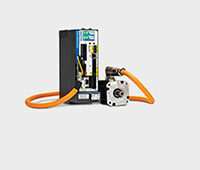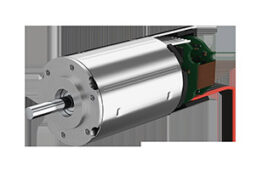By Paul Heney, Editorial Director
An engineering firm that designs seals for wind turbine bearings used finite-element analysis software to simulate the performance of a seal or gasket and then an optimizing package to runs through hundreds of design and material possibilities to find a best fit for a wind turbine’s wide operating range.
“Reliable designs are what I call satisficing,” said Frank Schoenberg, a seal engineer with Freudenberg. “They satisfy operating requirements and suffice for quality.”
Every wind turbine contains at least four large diameter bearings, one to pitch each blade and the yaw bearing. Each needs two seals. “In a 3-MW turbine, there are about 75m of gasket, every millimeter is critical to performance,” he said.
Seals malfunction for a reasons such as temperature, load variations, and small variations from manufacturing.
“Small imperfections created during manufacturing are inevitable,” said Schoenberg, “and even small changes during elastomer production can significantly alter gasket-sealing characteristics, such as the material’s Shore hardness.”
Variations in manufacturing tolerances and other loads can deform a bearing and change the width of the gap between the inner and outer bearing rings. An axial offset of the two rings creates other problems. Also, the gasket’s coefficient of friction can have a large effect on the sealing function.

A 3MW turbine uses many meters of gasket such as the one in this study.
The search for solutions involves tradeoffs. For instance, how rigid must the gasket be to maintain shape under load? Then maintenance and everyday performance call for tradeoffs as well. The gasket should be easy to install and remain firmly in place during operation. Finally, there is the inevitable conflict between controlling cost and maximizing capability.
The design goal has shifted from creating a best part for a limited set of conditions, to making one that works acceptably well under a wide range of circumstances.
To find answers, Schoenberg’s team used Abaqus finite element analysis (FEA) software, and Isight optimization software—both from Dassault Systèmes 3DEXPERIENCE SIMULIA application. These let analysts simulate hundreds of variations and establish which best meets design goals.
The gasket in question is an extruded contact seal made of a proprietary elastomer. Its tasks are to protect large bearings from environmental hazards and seal the lubricating grease inside. Bearing diameters range from one meter on a pitch bearing to five meters on a slewing bearing, and with a typical cross-section of only 25 x 25 mm. Furthermore, the gasket is expected to perform for 20 years, even in highly demanding environments.
Field requirements include a pressure load from the grease, friction torque, and de-mounting force, all while hitting production cost targets. Designs are evaluated using physical prototyping and simulations.
The first analysis task is to create a meshed model to run in Abaqus. Setting up its characteristics was straightforward: Bearing metal is defined as inflexible compared to the elastomer gasket, which had nonlinear properties. Because the gasket is made from homogeneous material and symmetric, it is possible to model and mesh a 2D cross section, greatly reducing run times while still providing accurate results.

The cross section shows dozens of design details.
The analysts selected 14 parameters, geometric dimensions and material properties, for optimization. Design of Experiment methods in an Isight workflow identified the parameters with the greatest effects on performance. This initial screening cut the number to six crucial parameters.
The next phase let the optimizing program run about 200 experiments that parametrically tailored geometrical dimensions and material properties (the six variables).
“By identifying main effects, we could eliminate unimportant factors,” Schoenberg said, “and concentrate our efforts where they would most affect the outcome.”
The design is frequently updated to reflect changing customer specs and deployment locations so the resulting design is not a one-size-fits-all seal, explained Schoenberg. For instance, one design scenario defined a high priority on pressure resistance and low priority on cost, with friction and mounting force of medium priority. What’s more, the gaskets are made from only one elastomer, but it comes in different Shore hardnesses, resulting in about 20 distinct sub-materials.
Freudenberg’s systematic approach to exploring design concepts yielded good results.

Because the gasket is symmetrical and homogeneous, it is feasible to run a small FEA meshed model of the cross section with uniform pressure loading (arrows).
“We finalized a gasket with characteristics superior to those achieved with more standard methods,” said Schoenberg, “and it’s less sensitive to processing and manufacturing imperfections, as well as to operating conditions for the wind turbine.”
The new part performs well under nominal conditions (verified by physical prototyping), and it performs well despite “noise”—tolerances and other uncertainties – that inevitably influence the operations of slewing bearings.
The analysis set-up took time, but Isight shortened the optimization considerably. Compared to Freudenberg’s former method, running time for each iteration was reduced from 30 minutes to 0.1 seconds. Overall, computational times plummeted from an estimated 16,300 hours (about 678 days) to 100 hours.
“We got good results, made better-informed decisions, and increased our efficiency,” Schoenberg said. “We also established a meta-model that can be a starting point for cost-effective customization when a customer comes in with new demands and priorities.”
Freudenberg Group
www.freudenberg.com/en
Dassault Systèmes
www.3ds.com
Filed Under: Software • FEA, Green engineering • renewable energy • sustainability, Seals • O rings, MOTION CONTROL, Seals





Tell Us What You Think!